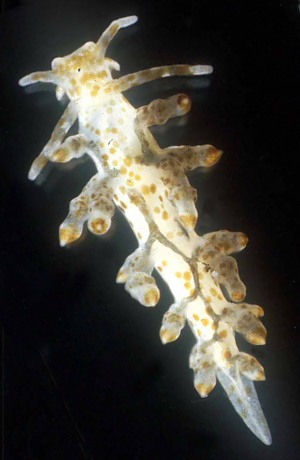Which is Eubranchus misakiensis?
September 11, 2002
From: Yoshiaki J. Hirano

Dear Bill,
Here is a photograph of Eubranchus misakiensis, which I took nearly 15 years ago. I collected the specimen in Mukaishima, Seto Inland Sea of Japan. I have been asked by you to confirm the identity of Bernard Picton's animal on March 10, 2001. I am very sorry that it took me really long to respond to it and later messages on the species.
In the case of E. misakiensis, too, intraspecific variation should obscure species identification, but from my experiences working on the species in Mukaishima and Abashiri (Okhotsk Sea) I do not have any impression that it is a very variable species in colouration: The original description by Dr Baba shows general ground-colour yellowish white; it is scattered with chocolate-brown spots everywhere on body, on cephalic tentacles and rhinophores, and on gills. Sole coloureless. Each of the branchial paillae with a yellow subapical ring and a bluish green liver-vein. These characters seemed always stable also when I observed several specimens found here in Kominato, Boso Peninsula. So, specimens with colouration very different from that of E. misakiensis seem rather different species than just variation. Plus, I think shape of foot corner is an important character to identify species. Please note the short horn shaped foot corners in my photo. But unfortunately with most of the photographs posted on the Forum I cannot clearly see that character. The followings are my comments on the photographs on the Forum.
I would like to give them following the chronological order of the posted photographs.
•(1) Those on Mar 10, 2001 by Bernard seem not of E. misakiensis, chiefly because it has too dense spots and quite different colour pattern on the cerata. (I hope this problem has been already solved.)
(2) As Erwin Koehler suggested on May 16, 2001, the picture in Dave Behren's book seems of E. misakiensis. I agree with Erwin on this.
(3)Those by Nishina Masayoshi on July 18, 2001 are probably not of E. misakiensis, because spots on the body are scarce and very red. Unfortunately the shape of foot corners cannot be seen from the photo. This animal looks very similar to that of the photograph of No. 222 on Opisthobranchs of Izu Peninsula by Keiu Suzuki (2000) and that of No. 1 of p. 802 of Marine Mollusks in Japan edited by Takashi Okutani (2001). The photograph No. 218 of Keiu's book is of E. misakiensis, I believe, but the animal on No. 222 looks very different from many specimens of E. misakiensis I have seen.
(4) The picture by Dave Behrens on May 25 is probably of E. misakiensis, as I mentioned above.
(5) Those by Marli Wakeling in two separate messages on May 25 (on which Dave Behrens agreed on species identification), and those by Nishina Masayoshi on the same day altogether seem not of E. misakiensis. As Marli mentioned in the first message, the animal reminds me of Eubranchus rustyus from the west coast of the US, but may be something else. The hydroid on which Marli's animals are crawling looks like a species of Plumularia or some related genus. I feel there are not any positive reasons to assign the specimen to E. misakiensis.
Best wishes,
Yoshi
hiranoyj@earth2.s.chiba-u.ac.jp
Hirano, Y. J., 2002 (Sep 11) Which is Eubranchus misakiensis?. [Message in] Sea Slug Forum. Australian Museum, Sydney. Available from http://www.seaslugforum.net/find/7895Dear Yoshi,
Your photo is very welcome. Many of the species which have been described from Japan, including Eubranchus misakiensis, were not well illustrated in their original descriptions, and so cause problems for us who are unfamiliar with your fauna. In the black and white drawing accompanying the descriptions of this species, the spots are drawn much smaller than in your photo. That is why I have been waiting for someone from Japan with a personal knowledge of these species to help us determine which of the brown-spotted species is E. misakiensis. Now that I have seen your photo I agree with your comments that the only other animal on this page that looks like . misakiensis is Dave Behrens' from California.
It would be good to have a comment from Dave on Marli's animals from Canada. Are they likely to be E. rustyus? I see that the Marcus's description of E. rustyus is another example of an unfortunately uninformative description. The specimens were described from decolorised preserved animals, the only information on the live animal being 'The living animals were white to translucent with pink cerata'.
I think I will remove all the 'non-misakiensis' photos from this page but before I do so I will see if anyone can give me any clues to their real identity. For example, the animal in Nishina's message from Japan has a distinctive colour pattern and ceratal shape. I have checked all the species I think have been described from Japan without success, but perhaps I have missed one.
best wishes,
Bill Rudman
Related messages
-
Re: which is Eubranchus misakiensis?
From: Jeff Goddard, July 15, 2003 -
Re: Which is Eubranchus misakiensis?
From: Marli Wakeling, June 25, 2003 -
Re: Which is Eubranchus misakiensis?
From: Nishina Masayoshi, September 13, 2002 -
Re: Which is Eubranchus misakiensis?
From: Dave Behrens, September 13, 2002 -
Eubranchus misakiensis in California
From: Dave Behrens, May 25, 2002 -
Eubranchus misakiensis? from British Columbia
From: Marli Wakeling, May 25, 2002 -
Is this Eubranchus misakiensis?
From: Nishina Masayoshi, May 25, 2002 -
Eubranchus misakiensis from British Columbia
From: Marli Wakeling, May 25, 2002 -
Eubranchus misakiensis from Vancouver, Canada
From: David Behrens, May 25, 2002 -
Eubranchus from Hachijo Is, Japan
From: Nishina Masayoshi, July 18, 2001 -
Re: Eubranchus misakiensis from Hong Kong
From: Erwin Koehler, March 16, 2001
